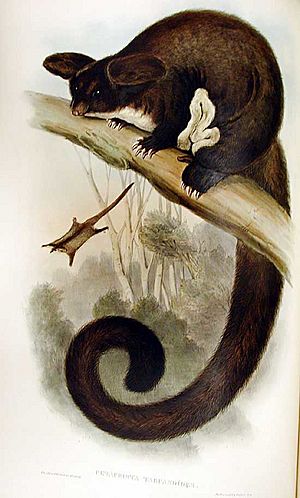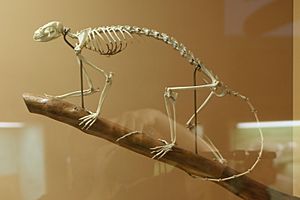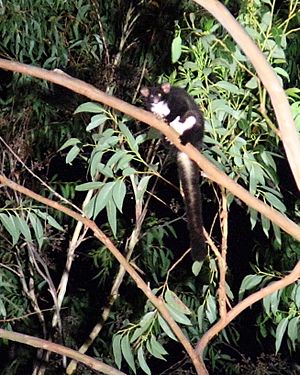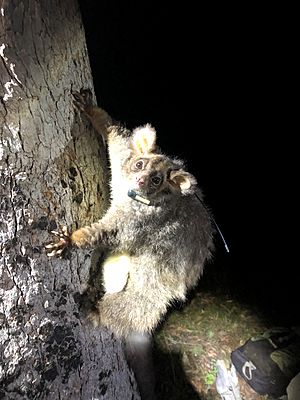Greater glider facts for kids
Quick facts for kids Greater glider |
|
|---|---|
 |
|
| Conservation status | |
| Scientific classification | |
| Genus: |
Petauroides
|
| Species: |
volans
|
 |
|
| Greater glider range | |
| Synonyms | |
|
Schoinobates volans |
|
The greater glider is the name for three types of large gliding marsupials found in Australia. For a long time, scientists thought there was only one type of greater glider, called Petauroides volans. But in 2020, new studies showed there are actually three different species! The two new species were named Petauroides armillatus and Petauroides minor.
Even though they glide like sugar gliders, greater gliders are actually more closely related to ringtail possums, especially the lemur-like ringtail possum.
Greater gliders are nocturnal, meaning they are active at night. They are also herbivores, which means they eat plants. They mostly eat Eucalyptus leaves and buds. You can find greater gliders in two main colors: a dark brown or a grey-to-white.
These amazing animals live in eucalypt forests from Mossman, Queensland, all the way down to Daylesford, Victoria.
Contents
What Makes a Greater Glider Special?
It's hard to tell the three species apart just by looking at them. This is why scientists didn't realize they were different for over 200 years!
Greater gliders have a head and body that is about 39 to 43 centimeters (15 to 17 inches) long. Female gliders are usually a bit bigger than males. Their body is covered with thick, shaggy fur, which makes them look even larger. They also have a long, bushy tail, about 44 to 53 centimeters (17 to 21 inches) long. Their head is short with a pointy nose, and their big ears have long fur around them.
How They Glide
On each side of their body, greater gliders have special skin flaps called membranes. These membranes stretch from their elbow to their ankle. This allows them to perform amazing controlled glides through the air! Other gliding marsupials, like the sugar glider, have membranes that stretch from their wrists to their ankles.
Their feet have strong, curved claws that help them grip onto tree bark. They have five toes on each foot. Some of their toes can even act like thumbs, helping them hold on tight.
Their fur is very soft and can be up to 60 millimeters (2.4 inches) long. The color of their fur can change, even within the same group of gliders. It can be white, brown, or even charcoal grey. Gliders in southern Victoria can weigh around 1600 grams (3.5 pounds), while those in northern Queensland might only weigh about 600 grams (1.3 pounds).
Staying Cool and Eating Tough Leaves
Greater gliders keep cool by licking their paws and belly. The main way they cool down is by letting the water evaporate from their skin. They can also use their gliding membranes to help keep warm by trapping a layer of air close to their body. Gliders don't handle very hot weather well, as they don't use water efficiently for cooling, and water can be hard to find in their tree homes.
These gliders are experts at digesting tough, low-nutrient leaves. They especially love Eucalyptus leaves, which can be hard for many animals to eat. Eucalyptus leaves have special chemicals and lots of tough fiber. But greater gliders can digest about 50-60% of the leaf as it passes through their body. They have a special part of their gut called a caecum. This caecum has helpful bacteria that break down food that wasn't digested in the first part of their gut.
Where Greater Gliders Live
The greater glider lives in southern Queensland, eastern Australia, southeastern New South Wales, and the mountain forests of Victoria. Scientists often find them by shining a light at night (called spotlighting), using radio tags, or playing owl calls.
Greater gliders choose their homes based on a few things. The most important is the type of eucalypt trees in the area. They like forests with trees like manna gum (E. viminalis) and mountain gum (E. dalrympleana). Having E. cypellocarpa trees also seems to make a habitat better for them. They also prefer areas about 845 meters (2,772 feet) above sea level. Within a good forest, they like older, taller trees.
How Greater Gliders Behave
Greater gliders are mostly nocturnal. This means they spend their nights looking for food high up in the trees. During the day, they sleep in hollow parts of trees. Each glider might use up to twenty different dens within its home area! They often line their dens with leaves and strips of bark to make them cozy.
Spotlighting is a popular way to find gliders. If you shine a strong light at a glider's eyes, you'll see two bright red glowing spots looking back at you!
Male and female gliders have their own territories within the forest. Males usually have larger territories, from about 1.4 to 4.1 hectares (3.5 to 10 acres). Females have slightly smaller territories, from 1.3 to 3.0 hectares (3.2 to 7.4 acres). Even if their territories overlap, gliders usually live alone outside of the breeding season and don't interact much.
Gliding Style
The way greater gliders glide is special among marsupials. They fold their front legs so their wrists are tucked under their chin. This makes their gliding membrane look like a triangle when they stretch it out. They glide regularly between tall trees and can use their tails to help them steer. They try to avoid moving on the ground because they are slow and clumsy there.
Greater gliders don't make loud sounds. Scientists think they communicate by leaving their scent marks around. Their special glands give them a slightly musky smell.
What Greater Gliders Eat and Who Eats Them
Greater gliders eat almost only the young leaves and flower buds of certain eucalypt trees. They especially like Eucalyptus radiata, Eucalyptus viminalis, and Eucalyptus acmenoides. They prefer young leaves because they have more protein and less tough fiber, which doesn't give them any nutrition. Overall, eucalypt leaves are not a very rich source of food.
Since greater gliders are active at night, one of their main predators is the Powerful Owl. These owls hunt by staying in one area until there are fewer gliders, then they move to a new hunting spot. Other animals that hunt gliders include feral cats, which were brought to Australia by Europeans.
Life Cycle and Reproduction
Greater gliders have a short breeding season, from February to May. Babies are usually born between April and June. Female gliders have a well-developed pouch that opens towards the front of their body. Inside the pouch, there are two teats. Only one baby, called a joey, is born each year.
When a joey is born, it's tiny, weighing only about 0.27 grams (0.01 ounces). It stays in its mother's pouch for about four months, growing fur and developing. After leaving the pouch, the mother might carry the joey on her back until it stops drinking milk at about seven months old. Young gliders become independent at nine months and can have their own babies when they are between 18 months and two years old.
Greater gliders have been known to live for up to fifteen years!
Conservation Status
Greater gliders are listed as a vulnerable species. This means their numbers are decreasing, and they need protection. They are protected by laws in Australia, Queensland, and Victoria.






